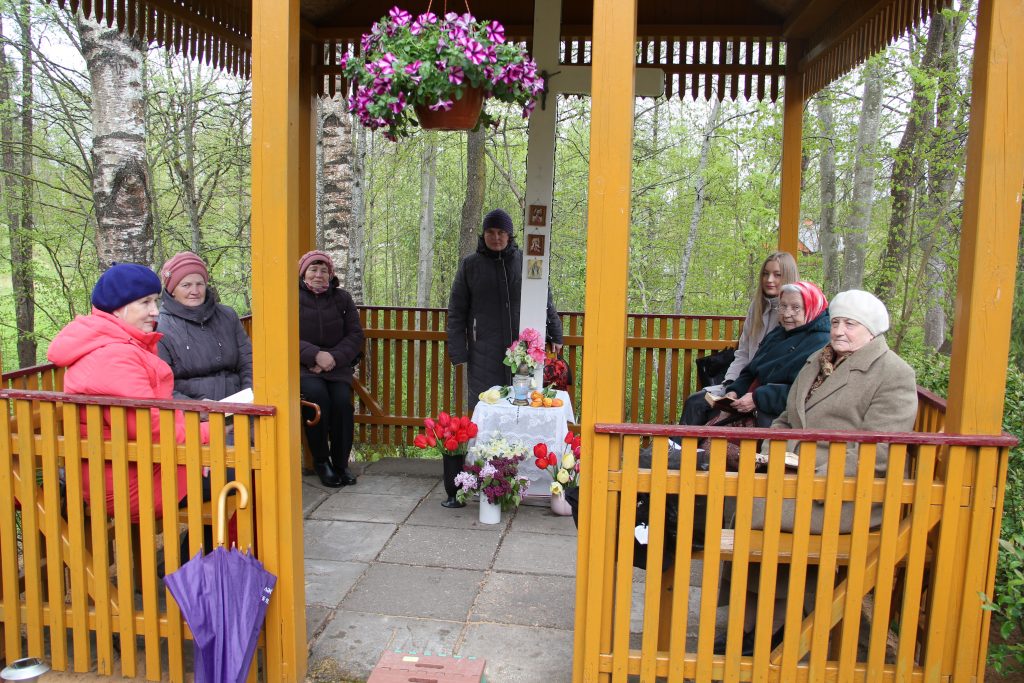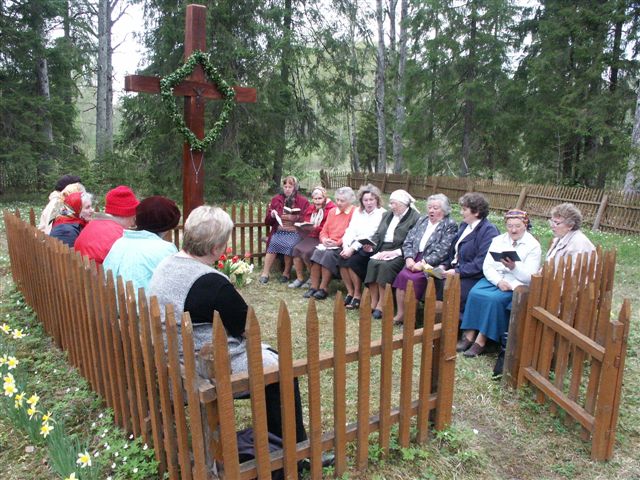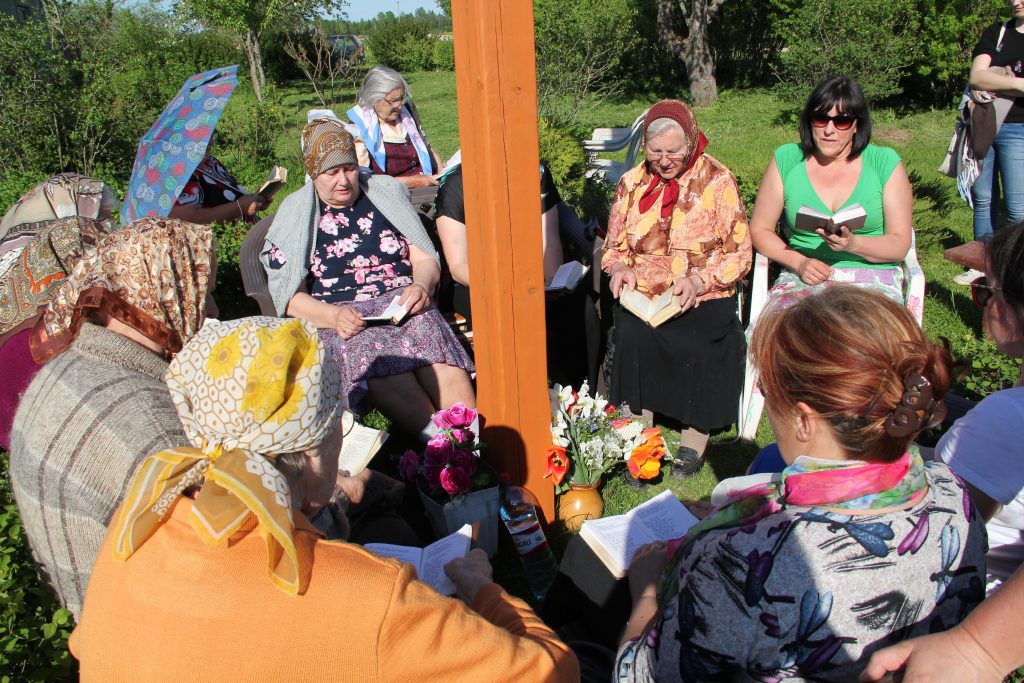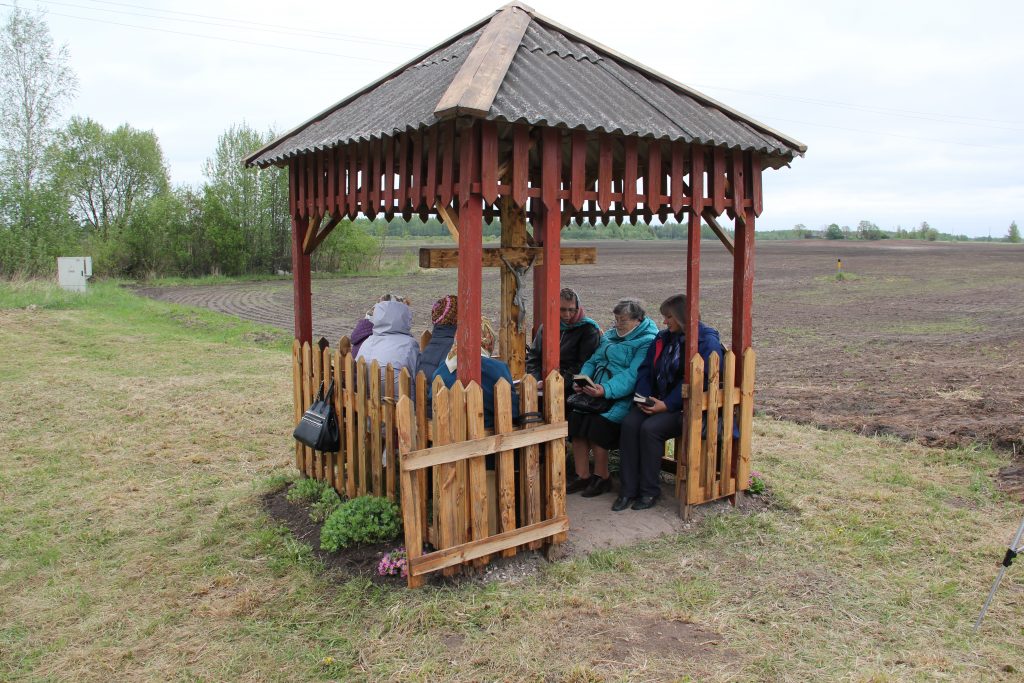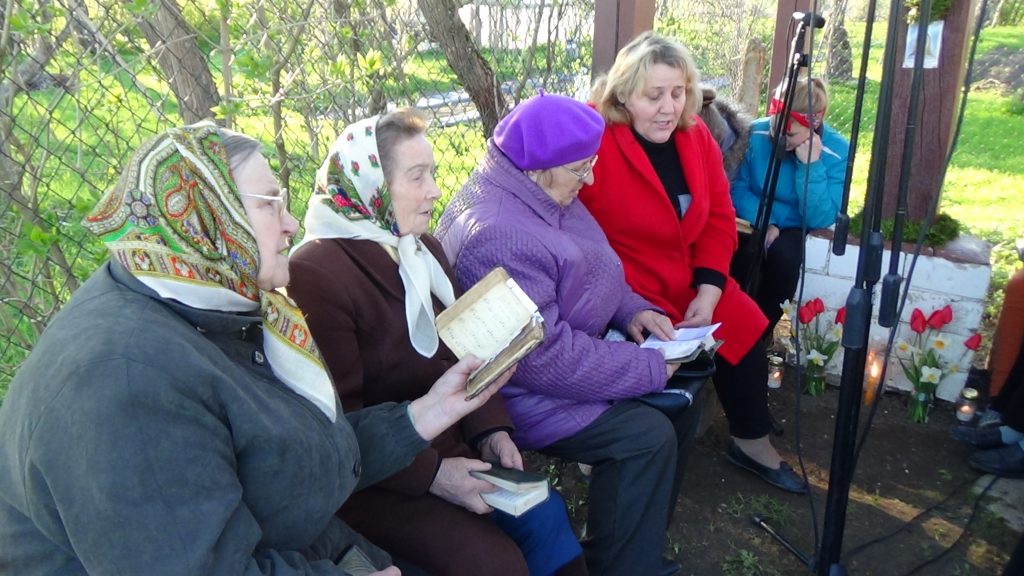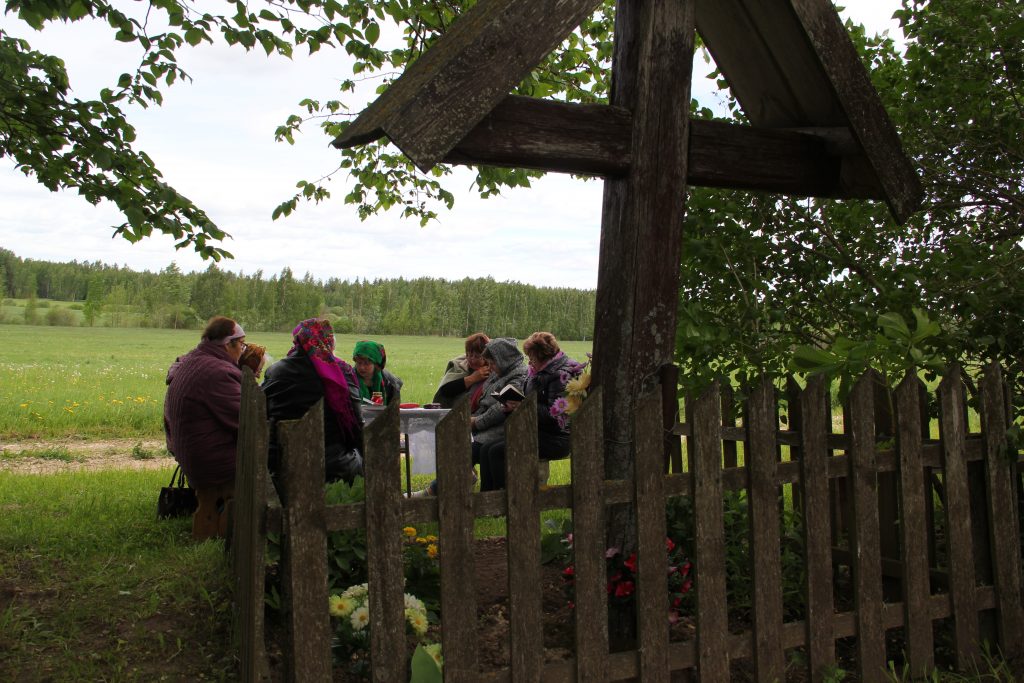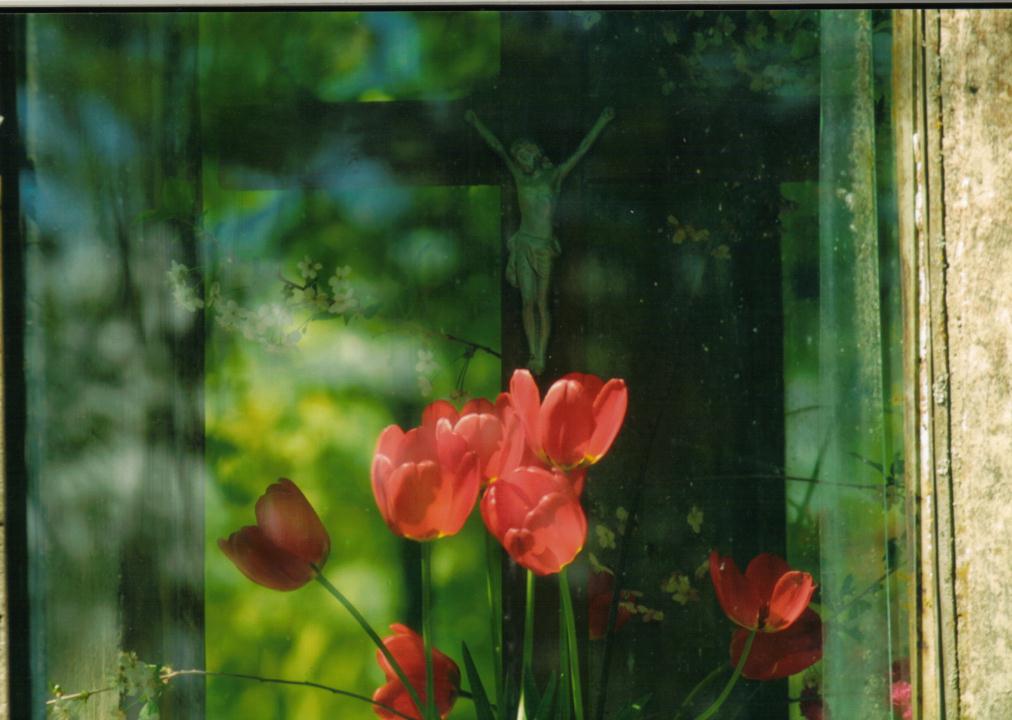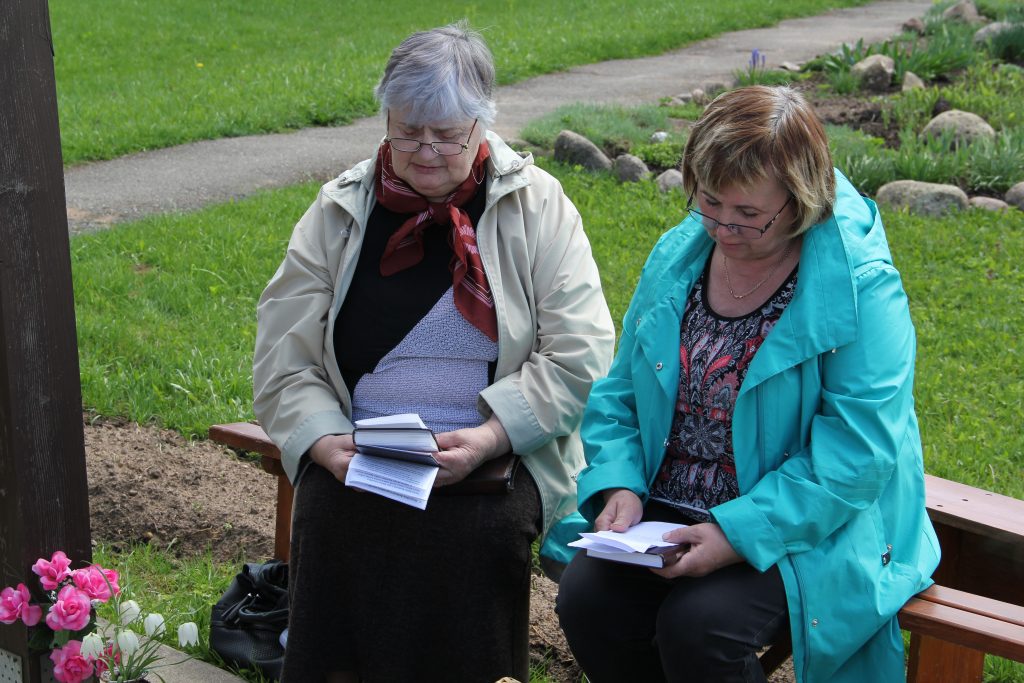Author:
Anda Beitane, Ruta Cibule
Oral traditions and their expressions, including language as a vehicle of intangible cultural heritage
Title
May Devotional Singing at Wayside Crucifixes in Northern Latgale (2020)
Singing by the crucifix in honour of the Virgin Mary
Geography
Northern Latgale (Balvi, Baltinava, Rugāji, and Viļaka Municipalities). ). Found to varying degrees with local variations across Latgale.
Northeastern Latgale (present-day Balvi, Baltinava, Rugāji, and Viļaka municipalities), located in the transitional zone between the Adzele elevation of the East Latvian lowland and the Mudava lowland. In the east, the area is marked by the Latvia-Russia border and in the west by the marshy, underpopulated Daugava-Mudava watershed.
During the first period of independence, the ancient Latgalian lands of Purnova and Ābelene were a part of the Abrene district.
In the twentieth and twenty–first centuries the area remained removed from major development and transportation corridors. Because of this, a large percentage of the population in this area remains Latvian (Latgalian) and retains living traditions and dialects.
This is Catholicism’s northernmost point in Europe, with a population of people who are aware of their position in the world and willing to accept responsibility for nurturing their heritage. Almost all the seventeen parishes in northern Latgale and the towns of Balvi and Viļaka have at least one singing group that practices May devotional singing.
Significance in community life
May devotional singing at crucifixes is an integral component of traditional culture in northern Latgale, as it is elsewhere in Latgale.
It is part of the wider Catholic musical tradition that also encompasses Lithuania and Poland.
Like other places where May devotional singing is practiced, northern Latgale has its own distinguishing features. These are, of course, linked to the people, their individual life experiences, and their experience with tradition. Every village has a crucifix where singing takes place in honor of the Virgin Mary.
In reality, this is a story about many communities because, in the context of May devotional singing, each community has taken shape in relation to a particular crucifix and continues to develop as an entity unto itself. Although all crucifix communities have characteristics in common, each also has its own local features that are expressed through the choice of repertoire, performance style, and associated customs.
Although devotional singing at crucifix sites was strictly forbidden and subject to severe punishment during the Soviet occupation, the fact that people continued to practice this tradition is evidence of the magnitude of its importance. There are documented cases of several singers who concealed crucifixes in their homes during this time.
Devotional singing at crucifix sites means much more to the singers themselves than just singing. It is simultaneously prayer and worship, which are an essential part of Catholic life in Latgale. The Church has not traditionally involved itself in devotional singing; it remains in the hands of the singing community.
Activities
Devotional singing usually begins with the recitation of the rosary and a litany of the Holy Virgin Mary, which are followed by other Dīva dzīsmes [songs of God], which is how singers refer to the songs found in Roman Catholic prayer books. Since the entire month of May, including devotional singing, is dedicated to the Virgin Mary, songs in honor of Mary (Marijas dzīsmes) are sung most often, although songs in praise of God are also sung.
Singing takes place from prayer books, but these only contain the words. Newer editions sometimes include musical notation, but since most singers do not read music, this is of little significance. The melodies are passed on orally from generation to generation.
Each crucifix community has one (occasionally more than one) lead singer who selects the songs. She usually also begins the singing and the prayers. Prayers may also be said several times between songs. Singing most often takes place outdoors at crucifix sites, which are usually fenced-in enclosures with benches so that singers can sit down, since singing lasts about an hour.
Crucifixes may be located in the middle of a village, another public place, along a roadside or at a singer’s home. The crucifixes are beautifully decorated, usually by one of the community members. In some cases, devotional singing takes place at crucifixes in cemeteries, churchyards, or inside a church.
Beliefs, rituals, and unwritten rules
On occasion, drawing “značkas” is also practiced between songs.
“Značkas” are assignments written on small pieces of paper that are to be completed in the next day, week, or month. Each participant draws a “značka” and reads it aloud. It might, for example, be an instruction to recite a particular prayer or perform a task.
It also specifies how the task must be performed, for example, to say five prayers while lying in the shape of a cross. These assignments are then conscientiously performed. The lead singer usually keeps the “značkas” in her prayer book and organizes the draw.
Passing on and transferring skills
Ways of passing on the element:
• Active practice, which inspires people who are not involved in the practice but regard it with respect and awe;
• On occasion, projects are developed, for example, in Baltinava where meetings are arranged during May between youth and tradition bearers of the older generation of devotional singing;
• In some parishes (Medņeva, Vectilža, Tilža, Baltinava), specific groups travel to parishes that no longer have local tradition bearers at the invitation of culture workers or leaders of ethnographic groups, who set the schedule in advance. These events are advertised well in advance and open to other participants.
History
According to Mārtiņš Boiko, not enough research has been done to determine how long May devotional singing has been practiced. He believes it may have originated in the second half of the nineteenth century. “In Latgale and Augšzeme, they took shape as a local example of a Catholic tradition that was already widespread in the nineteenth century” (Boiko, www.letonika.lv). Devotional singing in Northern Latgale took place every evening in May until the middle of the twentieth century.
Despite the efforts of the occupying Soviet power to eradicate this tradition by destroying the crucifixes and prohibiting devotional singing, May devotional singing persisted covertly, albeit with less intensity. The practice continued either at homes, where the crucifixes were hidden, or at cemeteries. Many crucifixes were restored in the early 1990s. After Latvian independence was restored, devotional singing also made a return. It no longer took place every evening, rather once or a few times weekly or even less often.
Today, May devotional singing continues to be an integral symbol of piety and a source of pride in Northern Latgale. This is one of only a few forms of traditional culture that functions outside institutional control and as an object of concern for municipal culture workers.
In the spring of 2019, 120 crucifixes were documented in Northern Latgale. Each of these has a distinct story in terms of its appearance and the singing practices associated with it. Devotional singing takes places at approximately sixty crucifix locations at least once a month. The frequency can vary. Singing takes place every day only at the crucifix in Kubuli parish, Balvi municipality.
As the rural population declines, the number of people in these singing groups also declines.
The Bērzpils parish in Balvi municipality is an interesting example, which is a place where devotional singing takes place several times a week at eight of sixteen extant crucifixes. Each crucifix has its own small, regular group which is not organized by culture workers or the municipality. In the context of May devotional singing in Northern Latgale, Bērzpils parish has been the least touched by institutionalization.
In several other parishes, for example, Baltinava, Medņeva, Tilža and Vectilža, the local folklore group and culture workers are involved in organizing May devotional singing. This ensures that singing also takes place in locations where there are no permanent residents. There are crucifixes where a single individual sings once a month, and crucifixes where there is no activity.
Time has also brought change to the song repertoire. Less frequently singers use the so-called “old books”, which are characterized by older forms of expression and contain songs that are not found in the “new books”. It could be said that the repertoire is becoming newer, as contemporary compositions enter the tradition, often becoming popular and prevailing over the older songs.
Unfortunately, there is a tendency for the multi-part singing that was characteristic of the Northern Latgale repertoire to disappear. Unison singing is increasing.
Additional Information
The tradition is particularly cherished because of its ability to retain its deeper meaning and function without institutional participation.
However, time brings change. All four municipalities are involved with the element to varying degrees. These include Balvi Municipality, Baltinava Municipality, Rugāji Municipality, Viļaka Municipality, and their institutions.
Masters
• Celīna Kaupera, Briežuciems parish;
• Anna Pundure, Briežuciems parish;
• Silvija Slišāne, Briežuciems parish;
• Aina Logina, Briežuciems parish;
• Anastasija Gabrāne, Briežuciems parish;
• Marija Sīle, Briežuciems parish;
• Silvija Dzerkale, Briežuciems parish;
• Valentīna Keiša, Briežuciems parish;
• Valentīna Kamzola, Briežuciems parish;
• Leontīna Šakina, Briežuciems parish;
• Alla Fjodorova, Briežuciems parish;
• Līvija Ločmele, Briežuciems parish;
• Ineta Apšeniece, Briežuciems parish;
• Ināra Kamzola, Briežuciems parish;
• Valentina Ločmele, Briežuciems parish;
• Anita Pakalnīte, Briežuciems parish;
• Skaidrite Pakalnīte, Briežuciems parish;
• Maruta Ločmele, Briežuciems parish, Ošukalns;
• Maruta Ločmele, Surikova;
• Genovefa Zelča, Briežuciems parish;
• Marija Deksne, Briežuciems parish;
• Līvija Cibule, Briežuciems parish;
• Marianna Laganovska, Briežuciems parish;
• Anita Platniece, Briežuciems parish;
• Leontīna Slišāne, Briežuciems parish;
• Ilze Erdmane, Baltinava;
• Sarma Sutugova, Baltinava;
• Anele Vizule, Baltinava;
• Iveta Gabrāne, Baltinava;
• Antoņina Krakope, Baltinava;
• Anastasia Ločmele, Baltinava;
• Antonija Toma, Baltinava;
• Valentīna Daukste, Baltinava;
• Elizabete Kaņepe, Baltinava;
• Lucija Ločmele, Baltinava;
• Anna Stranga, Bērzkalne parish;
• Marta Korlaša, Bērzkalne parish;
• Irēne Sīle, Bērzkalne parish;
• Anita Šmite, Bērzkalne parish;
• Silvija Strupka, Bērzkalne parish;
• Elfrīda Ābeltiņa, Bērzkalne parish;
• Irena Jasinska, Bērzkalne parish;
• Mārīte Bondarenko, Bērzkalne parish;
• Skaidrīte Saleniece, Bērzkalne parish;
• Anna Cibule, Bērzkalne parish;
• Anna Sudare, Bērzpils parish;
• Marijanna Jurkāne, Bērzpils parish;
• Broņislava Spalviņa, Bērzpils parish;
• Biruta Bogdane, Bērzpils parish;
• Ilga Rakstiņa, Bērzpils parish;
• Anna Sideļņika, Bērzpils parish;
• Aloizs Svelpe, Bērzpils parish;
• Veronika Odumiņa, Bērzpils parish;
• Anna Bitaine, Bērzpils parish;
• Ināra Kriviša, Bērzpils parish;
• Aivita Rakstiņa, Bērzpils parish;
• Adrija Šustere, Bērzpils parish;
• Antoņina Dundeniece, Bērzpils parish;
• Stefānija Kindzule, Bērzpils parish;
• Lucija Gaspažiņa, Bērzpils parish;
• Anna Poševa, Bērzpils parish;
• Marija Švekere, Bērzpils parish;
• Anna Jurkāne, Bērzpils parish;
• Helēna Mārtuža, Bērzpils parish;
• Veronika Čudare, Bērzpils parish;
• Anna Kindzule, Bērzpils parish;
• Ingrida Svelpe, Bērzpils parish;
• Pēteris Delveris, Bērzpils parish;
• Zita Delvere, Bērzpils parish;
• Līksma Pugače, Tilža parish;
• Anna Sisojeva, Tilža parish;
• Anna Kaņepe, Tilža parish;
• Inese Zelča, Tilža parish;
• Anna Jermacāne, Tilža parish;
• Daiga Jēkabsone, Tilža parish;
• Inese Pujate, Tilža parish;
• Zane Pulča, Tilža parish;
• Ināra Indriķe, Tilža parish;
• Jolanta Kaša, Tilža parish;
• Aina Zelča, Tilža parish;
• Marija Gorščale, Kubuli parish;
• Ināra Pugeja, Kubuli parish;
• Maruta Ozola, Kubuli parish;
• Marija Bukša, Kubuli parish;
• Tekla Kozlovska, Kubuli parish;
• Ināra Kaičenko, Kubuli parish;
• Maija Osmane, Kubuli parish;
• Adelaide Pipcāne, Kubuli parish;
• Nellija Lielbārde, Kubuli parish;
• Aija Pumpure, Šķilbēni parish;
• Ineta Lapsa, Šķilbēni parish;
• Māris Pužuls, Šķilbēni parish;
• Irina Husare, Šķilbēni parish;
• Inese Slišāne, Šķilbēni parish;
• Simona Logina, Šķilbēni parish;
• Ārija Rudziša, Šķilbēni parish;
• Estere Husare, Šķilbēni parish;
• Inata Pužule, Šķilbēni parish;
• Jānis Circenis, Šķilbēni parish;
• Laurita Ločmele, Šķilbēni parish;
• Karīna Romanova, Šķilbēni parish;
• Karīna Rudziša, Šķilbēni parish;
• Kristīne Lapsa, Šķilbēni parish;
• Janīna Lapsa, Šķilbēni parish;
• Biruta Bebina, Kuprava parish;
• Velta Garā, Kuprava parish;
• Emerita Prancāne, Kuprava parish;
• Emerita Žabare, Kuprava parish;
• Edita Viļuma, Kuprava parish;
• Antonija Jermacāne, Vectilža parish;
• Inese Jermacāne, Vectilža parish;
• Sonora Logina, Vectilža parish;
• Marija Ločmele, Vectilža parish;
• Domicella Logina, Vectilža parish;
• Mārīte Logina, Vectilža parish;
• Antoņina Baltiņa, Vectilža parish;
• Mārīte Lazorenko, Vectilža parish;
• Maruta Arule, Vectilža parish;
• Inta Zaharāne, Vectilža parish;
• Natālija Šustova, Vectilža parish;
• Solveta Logina, Vectilža parish;
• Iveta Zelča, Vectilža parish;
• Elija Logina, Vectilža parish;
• Genovefa Jermacāne, Vectilža parish;
• Terēze Kaijere, Viļaka;
• Vineta Zetkalne, Viļaka;
• Anna Annuškāne, Viļaka;
• Inita Raginska, Viļaka;
• Guntars Skutels, Viļaka;
• Lidija Brokāne, Viļaka;
• Marija Pitkeviča, Viļaka;
• Evita Zaremba-Krīgere, Viļaka;
• Anita Zaremba, Viļaka;
• Lidija Šaicāne, Viļaka;
• Marta Dortāne, Viļaka;
• Valentīna Dortāne, Viļaka;
• Lūcija Šaicāne, Viļaka;
• Aldis Pušpurs, Susāji parish;
• Emerita Pranckune, Susāji parish;
• Anna Mačāne, Susāji parish;
• Anna Gabrāne, Susāji parish;
• Antoņina Kaļiņina, Susāji parish;
• Indra Mačāne, Susāji parish;
• Valentīna Romanovska, Susāji parish;
• Biruta Bukovska, Susāji parish;
• Marita Pitkeviča, Susāji parish;
• Lucija Korneva, Susāji parish;
• Vija Martuzāne, Krišjāņi parish;
• Inese Zelča, Krišjāņi parish;
• Aina Ločmele, Krišjāņi parish;
• Aina Zelča, Krišjāņi parish;
• Vitālijs Pujats, Krišjāņi parish;
• Ināra Galviņa, Krišjāņi parish;
• Ināra Zelča, Krišjāņi parish;
• Valentīna Pujate, Krišjāņi parish;
• Zenta Šakale, Krišjāņi parish;
• Lilija Zelča, Krišjāņi parish;
• Lilija Zelča, Madona;
• Sandra Ločmele, Medņeva parish;
• Helēna Locāne, Medņeva parish;
• Aina Prancāne, Medņeva parish;
• Valentīna Babāne, Medņeva parish;
• Marina Upīte, Medņeva parish;
• Anita Upīte, Medņeva parish;
• Zinta Babāne, Medņeva parish;
• Silvija Babāne, Medņeva parish;
• Malvīne Ločmele, Medņeva parish;
• Skaidrīte Šaicāne, Medņeva parish;
• Jevgenija Račāne, Vecumi parish;
• Anna Saveļjeva, Vecumi parish;
• Velta Logina, Vecumi parish;
• Maruta Kokoreviča, Vecumi parish;
• Olga Kokoreviča, Vecumi parish;
• Irēna Kuzmane, Vecumi parish;
• Elizabeta Logina, Vecumi parish;
• Genovefa Kokoreviča, Vecumi parish;
• Janīna Kokoreviča, Vecumi parish;
• Līvija Kokoreviča, Vecumi parish;
• Valentīna Keiša, Šķilbēni parish;
• Loreta Šakina, Šķilbēni parish;
• Gunita Šakina, Šķilbēni parish;
• Irmīna Slišāne, Šķilbēni parish;
• Iveta Logina, Šķilbēni parish;
• Marija Supe, Šķilbēni parish;
• Irēna Keiša, Šķilbēni parish;
• Malvina Romka, Šķilbēni parish;
• Anna Keiša, Šķilbēni parish;
• Laura Bukša, Šķilbēni parish;
• Dainis Keišs, Šķilbēni parish;
• Līvija Supe, Šķilbēni parish;
• Valentīna Mežaka, Šķilbēni parish;
• Aija Korneja, Šķilbēni parish;
• Anna Štekele, Lazdukalns parish;
• Ivars Vītols, Lazdukalns parish;
• Pēteris Jermacāns, Lazdukalns parish;
• Līga Zizlāne, Lazdukalns parish;
• Regīna Čudarāne, Lazdukalns parish;
• Iveta Uršaļska, Lazdukalns parish;
• Veronika Janiša, Lazdukalns parish;
• Vincentina Bukša, Lazdukalns parish;
• Emīlija Bondare, Lazdukalns parish;
• Līvija Luša, Lazdukalns parish;
• Zita Kuzma, Lazdukalns parish;
• Aija Ikstena, Lazdukalns parish;
• Judīte Pasikova, Lazdukalns parish;
• Valda Šmagre, Lazdukalns parish;
• Rudīte Kuzmina, Lazdukalns parish;
• Silvia Deksne, Lazdukalns parish;
• Iveta Birkova, Lazdukalns parish.
Agencies and institutions
• Balvi Municipality Council;
• Balvi Municipality Culture Department;
• Balvi Municipality Intangible Cultural Heritage Centre “Upīte”;
• The organization “Upītes jauniešu folkloras kopa”;
• Medņeva Parish Folk House;
• Šķilbēni Parish Cultural Centre “Rekova”;
• Baltinava Parish Culture House;
• Briežuciems Parish Folk House;
• Vectilža Parish Sports and Cultural Centre;
• Viduči Primary School, Baltinava Secondary School.
Consolidation
• In the 1990s, the Culture Department of the Balvi Municipality publicly expressed the opinion that May singing was an essential and important part of the national culture and invited people to join the tradition. The crucifixes at which the singing is held were collected and published in the district newspaper;
• In 2001, 2004 and 2006, the May carols became an essential part of the Balvi Spiritual Music Festival;
• In 2003 and 2004, a project called “May singing at crucifixes” was carried out, which foresaw the introduction of singing groups, the documentation of songs, photo shoots and a seminar with analysis of the material produced and a forecast of the future perspective of the tradition;
• Individual parishes, such as Briežuciems and Vīksna, attracted the financing of the CKF and LEADER programs for the restoration of crucifixes;
• A photo catalog of 108 Northern Latgale crucifixes was performed in 2008 and 2009;
• In 2016, the VKKF project for the involvement of children and young people in the May singing was implemented in Baltinava municipality;
• Every year, the North Latgale newspaper “Vaduguns” devotes at least one publication to the theme of May songs. Every year, the Balvi Municipality Museum makes at least one video documentation of the singing;
• In 2019, the North Latgale crucifixes (120) were re-documented, and information about singing groups was updated.
Tradition-keepers collectively do this without thinking about plans and perspectives, they simply do so without realizing the uniqueness of the case and the priceless charm of their actions. Activities so far have helped them understand the importance of their activities. Publicity has allowed the issue to attract younger people, as well as support from parish leaders when necessary. Good and regular cooperation with Jāzeps Vitols Latvian Academy of Music has developed, which means not only the involvement of ethnomusicologists and students, but also cooperation in international research and study programs. The May singing visit is included in the content of JVLMA ERASMUS students study program, which in turn means widespread international publicity as students come from different countries around the world and take with them not only the experience of the May singing adventure (students usually engage in singing) but also the warmth of the hearts of people in North Latgale.
The municipalities have always provided and provide their support to address the various organizational issues. Most often it is the provision of transport for elderly wives to and from the crosses, or to events at the Open-Air Museum or other activities where the tradition of May carol singing is presented.
Municipalities are willing to participate in supporting documentation and research. This is reflected in the transport provision for local journeys, providing accommodation and catering, the preparation of the information base necessary for the preparation of research.
In some cases, municipalities engage in cross-border infrastructure management, but it is based on the Community's responsibility.
The municipalities of Briežuciems and Vīksna have attracted project funding for the restoration and arrangement of the crucifixes.
On the other hand, there are several examples where the farmer who leases and treats the plot of land on which the crucifix is located assumes responsibility for restoring it.
In Susāji parish is an example when a private person restores a crucifix (Sviļpova, Egļova) every year.
In the parish of Susāji and Vecumi, individual persons have invested funds to build crucifixes at the place of their villages, where people are no longer practically living, as well as organizing singers and transport to these places at least once in the month of May.
Individual enthusiasts regularly renew and even add to the already rich family of crucifixes in the parish of Bērzpils. The Beļauski Crucifix (Bērzpils municipality), where regular chants are held, has also welcomed the participation of restorers from the Rēzekne School of Art and Design in its restoration.
Northern Latgale is not homogeneous, but in general it is characterized by a surprising willingness of people to care about irrational things. For the time being, this process does not require an artificially organized planning. Positive communication and support are provided from local governments, when necessary.
Continuation/development
To ensure the identification of the element:
• Cooperation with traditional music researchers and students will be continued through regular documenting of the May songs. At least one full recording will be made every year with the aim of covering as many and different singing groups as possible;
• Research results will be presented at local and international conferences as well as in researchers' publications;
• In the Northern Latgale newspaper “Vaduguns”, there will be at least one publication on the progress of the singing at one of the region's crucifixes every year. The development of the tradition is reflected in the “one-home” project of the society integration fund and media support fund;
• The application process for the SCCF Lifetime Scholarships and for the Regional Certificates of Recognition and Acknowledgement will continue;
• The collection and publication of singer-life stories in the cultural history database of the Baltic region will be continued;
• It is intended to continue active cooperation with “Radio Marija”, which makes regular live broadcasts from Latgale crucifixes every year. Maintain the share of Northern Latgale translations currently in the total range of broadcasts;
• Not to be coercive or demanding, but to support requests from local authorities for singing groups to address transport or infrastructure issues.
The aim of these measures is to preserve, not to lose. To promote it to attract new people. To research and document so as not to go shallow. Not to interfere, but to be present, so as not to distort or degrade.
Threats
The threat of May singing is caused by:
• The dramatic decline in the population in rural areas, including Northern Latgale;
• There is a potential threat to local form and version levelling in favor of another, possibly more popular singing option.
Applicant
Viļaka municipality
Image Gallery
Audio Materials
Video
Publications
Beitāne, Anda. (2018). Notes from Latvia. Multipart Music in the Field. European Voices: Audiovisuals 1. Compiled and commented by Anda Beitāne. Signal processing and mastering by Varis Kurmiņš. Vienna and Riga: Department for Folk Music Research and Ethnomusicology of the University of Music and Performing Arts Vienna. Jāzeps Vītols Latvian Academy of Music.
Beitāne, Anda. (2014). “Traditional Polyphony in the Officium Defunctorum in North-Eastern Latvia”. In Proceedings of the 6th International Symposium on Traditional Polyphony. Rusudan Tsurtsumia and Joseph Jordania, eds. Tbilisi International Research Center for Traditional Polyphony of Tbilisi Vano Sarajishvili State Conservatoire, 2014, 238–245.
Cibule, Ruta. (2020). Naapsarūbežuot ar kulturys radzamū daļu. Conversation with Ruta Cibuli: [interview with Award Central Library Director Ruta Cibule]/R.Cibule, S.Ūdre// LaKuGa [e-magazine] - 11.02.2020.
Gabranovs, Edgars. (2018). Dzīd pi krustiem mūspusē: [on May singing at crucifix in Kurna, Kubuli parish]/E.Gabranovs// Vaduguns. - ISSN 1407-9844. - No. 38 (2018, May 25), p. [1]: photogr.
Logina, Zinaida. (2016). Dziedot izdzīvo dvēseles vibrācijas: ["Radio Marija Latvija” in Tilža/text is told by R.Miķelsons, I.Laupace, A.Sisojeva, R.Cibule, record Z.Logina// Vaduguns. - ISSN 1407-9844. - No. 43 (2016, 3 June), p. 5; photo.
Logina, Zinaīda. (2020).Latgalē saka, - "dzīduošona pi krysta": [about the May singing tradition at the time when the gathering together is restricted by the country-specific emergency]/Zinaīda Logina; interviews Ruta Cibule, Helēna Locāne, Malvīne Ločmele, Silvija Babāne, Anna Prancāne, Anita Upīte, Lūcija Gaspažiņa, Ingrīda Svelpe, Ilga Rakstiņa, Broņislava Spalviņa, Marija Bukša, Tekla Kozlovska // Vaduguns. - No 37 (2020, 19 May), p. 7, photo gr.
Pantele, Guna (2002). The tradition of the May Service in Eastern Latvia. Book: Materials on Culture in Latvia. Riga: Zinātne, 200-214 p.
Radio Marija. (2017). Maija dziedājumi dažādos Latgales novados 2017.gads. DVD. / Radio Marija Latvija. Rīga: Radio Marija Latvija.
Rancāne, Anna. (2003). Ja ir krusts, tad jādzied: [on Catholic tradition - May singing at the crossroads in Sviļpova and Mastarīga]/Anna Rancāne; Aivara Liepiņa photo. - Interviews Baiba Supe and Anna Mežale from Baltinava parish and Anna Štekele from Lazdukalna parish// Diena. - (Piel. Sestdiena) - ISSN 1407-1290. - (2003, 31 May), pp. 16-19: photogr.
Zeltkalne, Vineta. (2019). Ceļmalas krustu tradīcija ir dzīva: [on the preservation of the May singing to crucifixes in Viļaka]/Vineta Zeltkalne; interviews Pr. G. Skutels and M. Jeromane// Viļaka municipality. - No. 5 (2019, 28 May), p. 12: photo.
Goldhill, Vineta. (2015). How to preserve the tradition of May singing?: [the month of May is hurried, the most charming singers and the stories of traditions, sanctioned every day by God's honour at crosses, crucifixes]/Vineta Zeltkalne// Control. - ISSN 1407-9844. - No. 42 (2015. June 9), p. 8, photo.
Zinkovska, Ingrīda. (2016). Dzied dziesmas Dievmātes godam: [about the May singing traditions in Baltinava municipality]/interviews psalm singer F.Avišāne, pupil M.Laganovska, head of the Central Library in Balvi R.Cibule, record. I.Zinkovska; photo A.Kirsanovs// Control. - ISSN 1407-9844. - No. 40 (2016, 24 May), p. 8; photo.
Websites
http://balvurcb.lv/kb/index.php?CategoryID=32 - information on more than 100 North Latgale crucifixes
http://balvurcb.lv/kb/index.php?CategoryID=29 - for May songs in separate parishes, including with added publication lists
http://balvurcb.lv/kb/index.php?CategoryID=74 - for more than 100 catolic traditional music practitioners
http://balvurcb.lv/kb/index.php?CategoryID=60 - Latvian Radio Cora Expedition Materials in North Latgale in 2009, including May songs. Berzpils, Tilja, Cape, Vilaka
https://www.letonika.lv/groups/default.aspx?title=LKK%20resurss/22 - short historical insight into tradition




